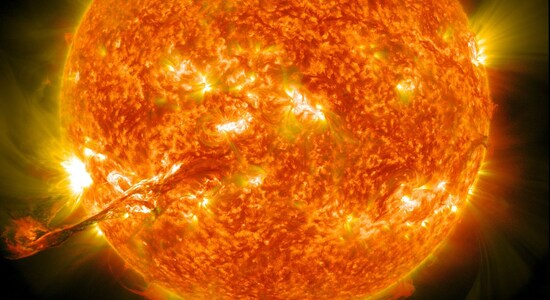
 1 / 9
1 / 9In recent months, Earth has been bombarded by a series of solar storms, and with the impending arrival of 'solar maximus' in 2025, scientists anticipate an escalation in both the frequency and intensity of captivating natural light displays known as auroras. Eruptions of plasma and magnetic fields from the sun’s corona lead to dazzling displays of northern lights on Earth. A look at how they are connected. (image: Unsplash)

 2 / 9
2 / 9How Auroras Form | Auroras are the breathtaking result of a cosmic dance between space weather and earth's magnetic fields. At any given moment, the Sun continuously ejects charged particles from its upper atmosphere, collectively known as the solar wind. Some of these charged particles venture into space and are eventually captured by earth's magnetic field. (Image: Shutterstock)

 3 / 9
3 / 9These cosmic travelers follow their magnetic path and funnel towards earth's polar regions. Upon entering earth's atmosphere, these energetic particles engage in a spectacular collision with molecules present in the air. The result? A mesmerising emission of light that we recognise as the aurora. (Image: Shutterstock)

 4 / 9
4 / 9The Science Behind the Collision | The journey of a charged particle from the sun to earth's atmosphere is a multi-step process. First, these particles collide with atoms in earth's atmosphere, typically occurring around 300 kilometers above our planet's surface. During this collision, electrons within these atoms absorb energy and move to higher-energy states, about 200 kilometers above the earth. (Image: Shutterstock)

 5 / 9
5 / 9When these energised electrons eventually return to their original, lower-energy state, they release a photon – a particle of light – around 100 kilometers above earth's surface. This beautiful cascade of events is what creates the ethereal display of an aurora. (Image: Shutterstock)

 6 / 9
6 / 9A Palette of Colors | Auroras showcase a stunning spectrum of colors that vary depending on the chemical composition of earth's atmosphere. Oxygen, for instance, is responsible for the enchanting yellow-green hues. The presence of both oxygen and nitrogen results in the fiery red glow, while nitrogen alone contributes to the vibrant violet and various shades of blue. (Image: Shutterstock)

 7 / 9
7 / 9Each type of atom or molecule in the atmosphere radiates its unique set of colors during these collisions, painting the night skies with a dazzling array of hues. (Image: Shutterstock)

 8 / 9
8 / 9Northern Lights vs. Southern Lights | The phenomenon of auroras is not confined to one hemisphere alone; it occurs both in the Northern and Southern Hemispheres. In the Northern Hemisphere, it is referred to as the "northern lights" or "aurora borealis," while in the Southern Hemisphere, it goes by the name "southern lights" or "aurora australis." Despite their different names, these celestial displays are physically identical, differing only in their geographic location. (Image: Shutterstock)

 9 / 9
9 / 9With solar activity on the rise as the sun approaches 'solar maximus' in 2025, the allure of auroras is set to captivate skywatchers around the world. As scientists continue to study the complex interplay between space weather and earth's magnetic fields, our understanding of this awe-inspiring phenomenon deepens, enriching our appreciation of the wonders of the cosmos. (Image: Shutterstock)

